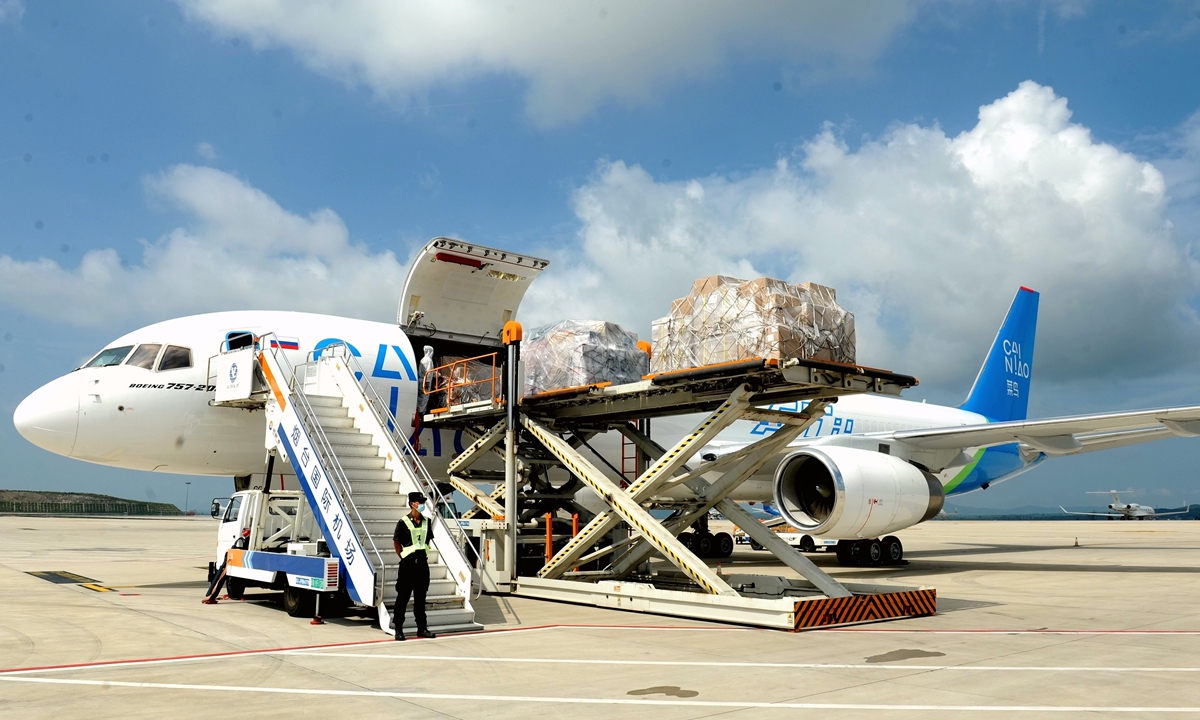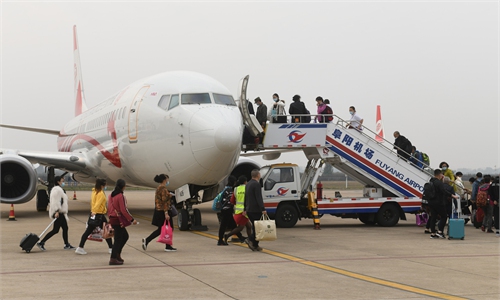Cargo could boost airlines profits
Airline income may decline by 60% during Spring Festival travel rush compared to last year

The first direct all-cargo plane from Yantai to Russia in Yantai, East China's Shandong Province, in August 2020. Photo: cnsphoto
Chinese airlines are expected to see a steep decline in passenger transport for the coming Spring Festival travel peak, damaging profitability.
Based on recent moves by airlines, the cargo business, has been benefited from medical supplies transport since the beginning of last year, is believe to be an important driving force to boost the airlines' performance this year, analysts predicted.
Strict travel control
Nationals returning home are expected to decline by 60 million due to the strict control measures in China, and more than 80 percent may cancel the trips, according to CADAS, third-party civil aviation passenger service evaluation agency of VariFlight on Thursday.
The figures were calculated after China rolled out measures to guide the public on their return journeys to their hometowns and urged them to stay in their working cities during the upcoming Spring Festival holidays.
Among the measures are mandatory nucleic acid tests within seven days of travel, 14-day health monitoring at home and an extra bonus as a stimulus for those who choose to stay.
At least 29 provinces and municipalities have taken steps in a bid to avert the risks of the virus' spread during the chunyun (travel rush) in Spring Festival, which is known as the world's biggest annual human migration.
According to Chinese authorities on Wednesday, this year's chunyun would see some 1.7 billion trips in total with a daily average of 40 million trips. The number is 40 percent lower than in 2019 but 10 percent higher than in 2020, officials said.
The Spring Festival has an important impact on the airline's annual revenue. "For years without COVID-19, during the 40-day Spring Festival travel peak, the overall passenger flight volume of the industry accounted for about 11.7 percent of the whole year, and revenue accounted for about 12.4 percent of the annual revenue." Lin Huaiyin, an analyst from CADAS told the Global Times on Thursday.
He predicted that the income generated by airlines during this year's Spring Festival travel peak will be around 60 to 70 percent of that in 2020, and 30 to 40 percent of that in 2019.
Cargo business rising
While the movement of individual passengers has been disrupted by travel restrictions, cargo flights have increased substantially, and cargo charter flights have doubled since 2020, which may give a hand for the airlines' profit.
Data showed that in the first three quarters of 2020, civil aviation cargo and mail transportation volume recovered to nearly 90 percent of the same period for the previous year; in the fourth quarter of 2020, driven by the e-commerce shopping festivals, many airports' air cargo volume is at a peak again.
On Monday, China Southern Airlines unveiled its cross border e-commerce center in its logistic firm in Guangzhou, South China's Guangdong Province, a move reflecting its ambition within cross-border business.
Wenzhou airport in East China's Zhejiang Province on January 12 also said it, together with local postal bureau and local transport department, will jointly promote the construction of local air cargo hub.
Chinese airlines have long eyed the growing cargo industry. The cargo arm of China Southern Airlines Co said in December last year that it has raised 3.35 billion yuan ($512 million) through a share sale, as part of a government-supported mixed ownership reform program that aims to reduce the carrier's financing costs by bringing in private backers, according to caixin.com.
So far, all the cargo arms under three State-owned airlines groups have transitioned to a mix-ownership model, making these businesses more independent.
Insiders said three major airlines in air cargo have its advantages in terms of cargo fleet, the belly space resources and the cargo dispatching capacity from the airport to airport, as well as the support of the route network accumulated over decades of operations. With the help of policy and the supply chain demand there is significant room for growth.
The International Air Transport Association (IATA) released data for global air freight markets in November showing that freight volumes improved compared to October, although remain depressed compared to 2019.
Specifically Asia-Pacific airlines reported a decline in year-on-year international demand of 9.5 percent in November 2020 compared to the same month a year earlier. This was a 2.2 percentage points improvement from the 11.7 percent fall in October 2020.
Challenges
However, insiders warn that growth within the cargo sector still has a heavy dependence on outbound business, in addition to the limited fleet size.
The domestic civil aviation transport fleet totaled 3,818 aircraft at the end of 2019, of which there were only 173 all-cargo planes, accounting for only 4.5 percent of the fleet, and only 52 medium and long-range all-cargo planes. Compared with the number of all-cargo planes in the US, which exceeds 1,100, the number of medium- and long-range all-cargo planes reached 547, Shao Fengru, who is from China Eastern Airlines, said in a forum at the end of last year.
"From the 12th Five-Year Plan period (2011-15) onwards, the average annual growth rate of air cargo and mail transportation in China has been only 3.3 percent, which is far lower than passenger routes," she added.
If overseas epidemic remains unaddressed, it is hard to see a full recovery, nevertheless for the gaining of the profits, Qi Qi, a market watcher told the Global Times on Thursday.

